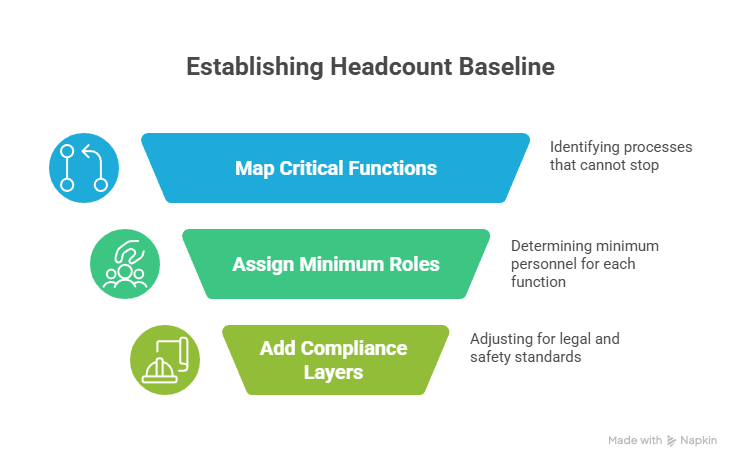
Why Headcount Planning During Strikes Matters
Strikes rarely occur in a vacuum. They usually arrive after a buildup of operational tensions, negotiations, or broader industry disruptions. For employers, the immediate concern is not only negotiating with labor representatives but also ensuring that the business can continue functioning at a sustainable level while the dispute plays out.
At the center of this challenge lies one critical question: What is the minimum headcount required to stabilize operations during a strike? The answer is not a static number. It depends on industry type, regulatory environment, union coverage, and the complexity of the work itself. Yet leaders who approach this issue with data, planning, and clear contingencies are better equipped to safeguard revenue, reputation, and customer trust.
Defining “Stabilization” in Operations
Before calculating headcount, executives must define what stabilization means in their context. For some, it may mean meeting 60–70% of customer demand while negotiations continue. For others, it could involve maintaining only safety-critical functions until full operations can resume.
Three typical stabilization benchmarks include:
- Revenue continuity: Keeping production or service levels high enough to avoid major financial losses.
- Regulatory compliance: Ensuring that safety, environmental, or industry-specific legal standards are not violated.
- Customer retention: Delivering enough output or service to prevent customers from permanently switching to competitors.
Each benchmark influences how “minimum headcount” is calculated. For example, in a hospital, stabilization may mean ensuring ICU, ER, and surgical staff coverage. In a manufacturing plant, stabilization could mean running one or two production lines at reduced capacity.
Factors That Determine Minimum Headcount
Determining the smallest viable workforce during a strike isn’t guesswork. It requires a layered assessment of operational dependencies, skillsets, and risk tolerance.
1. Industry Complexity
- Healthcare & Emergency Services: Staffing thresholds are non-negotiable due to patient safety and legal mandates. Even temporary understaffing can have life-or-death consequences.
- Manufacturing & Warehousing: Operations can often run at reduced throughput, but machine operators, safety personnel, and logistics coordinators remain essential.
- Transportation & Utilities: Minimum staffing is determined by regulatory standards—such as FAA requirements for airlines or federal safety mandates for utilities.
2. Skill Specialization
Not every employee is interchangeable. During a strike, organizations often prioritize:
- Mission-critical specialists (nurses, licensed operators, safety inspectors).
- Supervisory staff who can coordinate temporary or contract labor.
- Technical support roles necessary to keep systems functioning.
3. Regulatory and Contractual Obligations
Many industries operate under strict staffing mandates. For example, OSHA regulations may dictate minimum safety officer presence on a worksite, while transportation carriers must maintain certified operators for compliance.
4. Technology and Automation
Firms with advanced automation may stabilize with fewer workers, but technology often requires specialized oversight. A fully automated production line still needs engineers and IT staff to troubleshoot downtime.
Calculating the Headcount Baseline
Executives typically use scenario modeling to estimate stabilization thresholds. This involves three steps:
- Map Critical Functions: Identify processes that cannot stop without severe consequences.
- Example: In a chemical plant, this might be continuous-flow operations that cannot be shut down abruptly.
- Assign Minimum Roles: Determine the absolute minimum personnel required for each critical function.
- Example: A warehouse may need one supervisor, one safety officer, and three forklift operators to keep shipments moving at reduced capacity.
- Add Compliance and Safety Layers: Adjust the baseline to meet legal and safety standards.
The result is not a “perfect” workforce but a functional floor—a headcount number that keeps the operation viable during disruption.

The Strategic Importance of Contingency Staffing
Even the best strike planning cannot guarantee 100% continuity. But identifying and securing minimum headcount allows leadership to:
- Negotiate with confidence, knowing critical operations will not collapse.
- Protect customer relationships, by demonstrating reliability under pressure.
- Preserve revenue streams, even at partial capacity.
- Avoid regulatory fines or legal liabilities stemming from under-compliance.
Ultimately, stabilizing operations during a strike is about balancing two realities: minimizing short-term disruption and avoiding long-term brand erosion.
Financial Modeling: The Trade-Offs of Contingency Staffing vs. Shutdown
Executives often face a stark choice during a strike:
- Pay a premium for temporary labor, overtime, and contingency contracts to maintain operations.
- Or accept the cost of a partial or full shutdown.
1. Direct Costs of Contingency Staffing
Strike staffing agencies and temporary labor solutions typically come at 1.5x to 3x normal wage rates. This reflects both the urgency of supply and the risk premium workers expect to operate in strike conditions.
Additional costs may include:
- Travel and housing: When out-of-state staff are brought in.
- Security: Protecting contingency workers and facilities during tense labor disputes.
- Training and onboarding: Even skilled staff need orientation on safety protocols and operational processes.
2. Indirect Costs of Shutdown
While staffing premiums may appear expensive, the cost of shutting down completely is often catastrophic:
- Lost revenue: A plant producing $2 million in goods per week may lose $500,000+ weekly even if partially operating.
- Customer churn: Clients may switch suppliers if they perceive unreliability.
- Contract penalties: Many B2B agreements contain fulfillment or delivery penalties that trigger when obligations aren’t met.
3. Break-Even Analysis
Executives can use break-even analysis to evaluate whether contingency staffing is justified:
Example:
- Normal payroll: $40/hour per worker.
- Strike staffing premium: $80/hour.
- Minimum headcount needed: 50 workers.
- Weekly cost: $160,000.
Compare this to the cost of downtime:
- Average weekly revenue: $2 million.
- Expected loss at 40% reduced operations: $800,000.
- Full shutdown loss: $2 million.
In this scenario, paying $160,000/week for contingency labor is far more cost-effective than absorbing $800,000–$2 million in weekly losses.
Takeaway: Minimum headcount isn’t just about operations — it’s a financial decision that balances premium labor costs with revenue protection.
Geographic Factors: How State Labor Environments Influence Headcount
Strike planning looks different depending on where the business operates. Regulations, labor culture, and state-specific union environments all influence how “minimum headcount” is defined. Three notable examples are Illinois, Minnesota, and Texas:
Illinois
- Strong labor protections: Illinois has one of the nation’s more union-friendly climates, with higher strike participation in manufacturing, healthcare, and public services.
- Staffing mandates: Hospitals and care facilities face strict staffing ratio laws. Cutting below thresholds risks regulatory fines.
- Implication for headcount: Companies should plan for higher stabilization thresholds (closer to 60–70%) because regulators and unions are less forgiving of reduced coverage.
Minnesota
- Healthcare concentration: With world-class hospital systems and biotech hubs, healthcare strikes in Minnesota receive heightened attention.
- Political and public pressure: The state’s political climate leans toward strong worker protections, meaning under-staffing during strikes may attract both media scrutiny and regulatory consequences.
- Implication for headcount: Critical-care minimums are essential. Leaders in healthcare or life sciences should expect non-negotiable compliance-driven staffing levels.
Texas
- Right-to-work environment: Texas has weaker union protections compared to northern states, giving employers more flexibility to deploy contingency workers.
- Industry mix: Oil, gas, and transportation dominate — all of which are heavily regulated from a safety standpoint.
- Implication for headcount: Employers may stabilize operations at lower headcount percentages (30–40%) but must still meet strict safety and federal compliance requirements.
Common Questions About Minimum Headcount During a Strike
When executives search for solutions online, they often frame their concerns as direct questions. Below are answers designed to align with how Google surfaces information in featured snippets, while also providing deeper context for decision-makers.
What is the legal minimum staffing requirement during a strike?
There is no universal legal minimum headcount that applies to all industries during a strike. Instead, requirements are dictated by federal regulations, state laws, and industry-specific mandates.
- Healthcare: Hospitals and nursing facilities often fall under state-mandated staffing ratios for nurses and support staff.
- Transportation: The FAA, DOT, and other agencies dictate certified personnel requirements for planes, trucks, and rail operations.
- Utilities and Energy: Power plants, refineries, and chemical facilities may be required to maintain federally mandated safety staffing.
Implication: Companies cannot simply decide to run with a skeleton crew if doing so risks compliance violations. Leadership should consult legal counsel and industry regulators before finalizing headcount decisions.
How do you calculate minimum headcount in a warehouse or manufacturing plant?
The minimum headcount for warehouses and manufacturing depends on critical throughput and safety needs. A simple calculation framework includes:
- Identify essential roles (forklift operators, line technicians, supervisors, safety officers).
- Estimate reduced throughput (e.g., one active line at 40% capacity instead of three).
- Overlay compliance standards (OSHA safety officers, licensed machine operators).
For example: A distribution warehouse that usually operates with 45 staff may stabilize with 12–15 workers if those roles are strategically allocated.
Can automation reduce the number of workers needed during a strike?
Yes, automation and robotics can reduce staffing needs, but they do not eliminate them. Specialized operators, engineers, and IT staff are still required to monitor, troubleshoot, and repair automated systems.
- A plant with robotic assembly lines may run at 60% output with 40% of the staff — but only if skilled engineers are available to address breakdowns.
- A logistics center using automated conveyor systems still requires supervisors and safety staff on site.
Key takeaway: Automation reduces dependency on manual labor but increases reliance on technical expertise, which must be factored into minimum headcount.
What percentage of normal staffing is needed to stabilize operations?
Most industries stabilize operations at 30%–60% of their normal headcount, depending on complexity and safety requirements.
- Healthcare: Often requires closer to 70–80% due to patient safety.
- Manufacturing: Can sometimes stabilize at 30–40%.
- Warehousing/Distribution: Typically 40–50%.
Executives should model multiple scenarios to avoid underestimating headcount and triggering compliance or reputational risks.
How much does contingency staffing cost compared to full shutdown?
Temporary staffing, strike staffing agencies, or overtime for supervisors often cost more per worker than standard payroll. However, the overall financial damage of a full shutdown — lost revenue, broken contracts, customer churn — is almost always greater.
- Contingency staff premium:5x–3x regular wage rates.
- Shutdown costs: Can run into millions per week depending on industry.
This cost-benefit analysis underscores why minimum headcount planning is not optional but essential for risk management.
What roles should always be covered first during a strike?
Across industries, certain categories of workers must be prioritized when calculating the stabilization headcount:
- Safety-critical roles – inspectors, compliance officers, security staff.
- Licensed specialists – nurses, engineers, operators.
- Supervisory staff – essential for coordinating temporary or reduced crews.
- Customer-facing staff – to maintain client relationships and manage communications.
Failing to cover these roles risks not only immediate disruption but also long-term legal and financial exposure.










